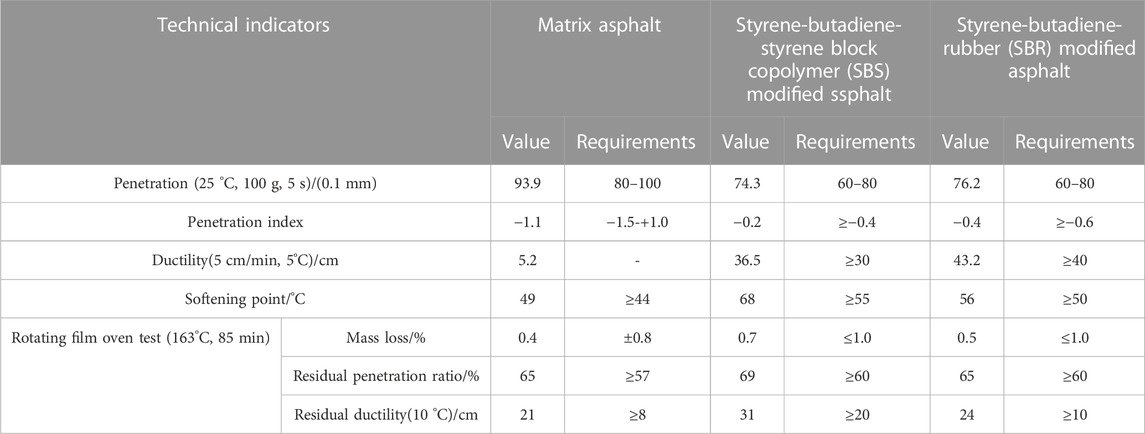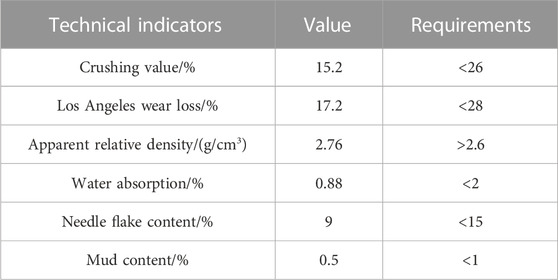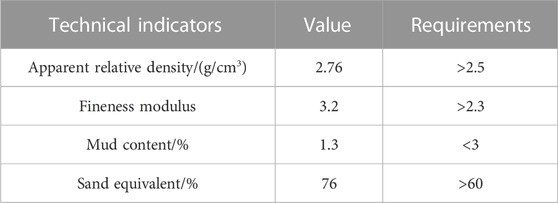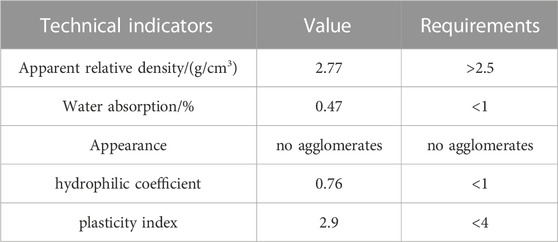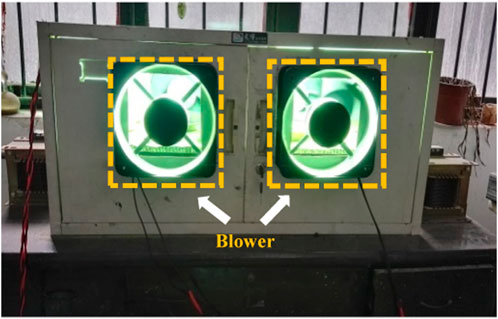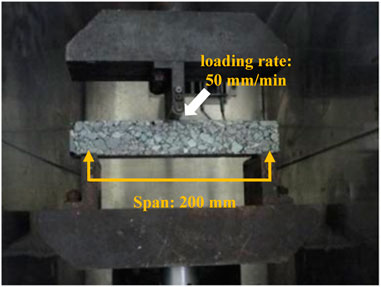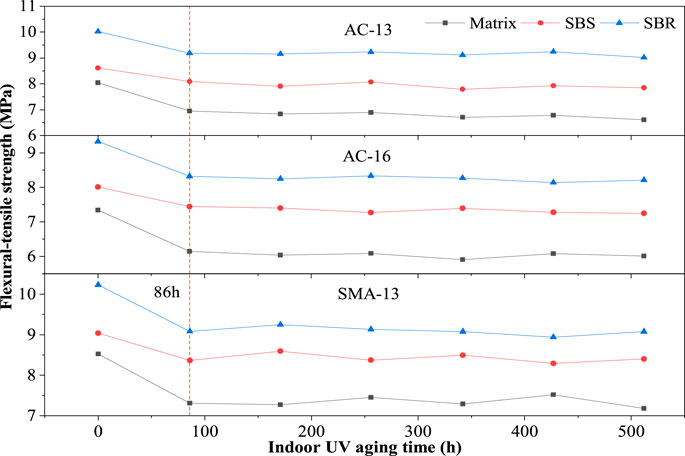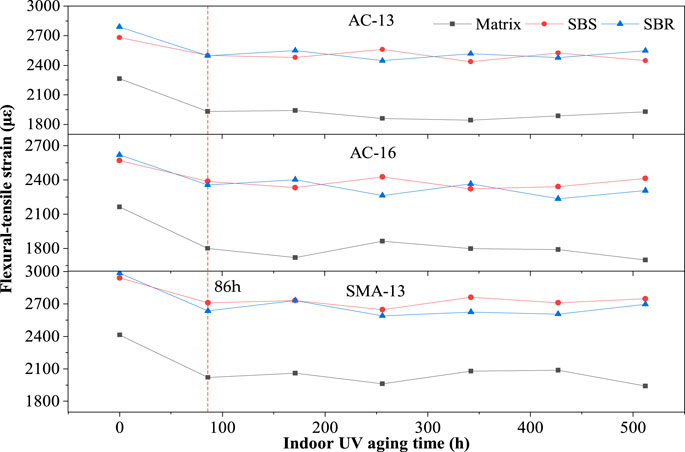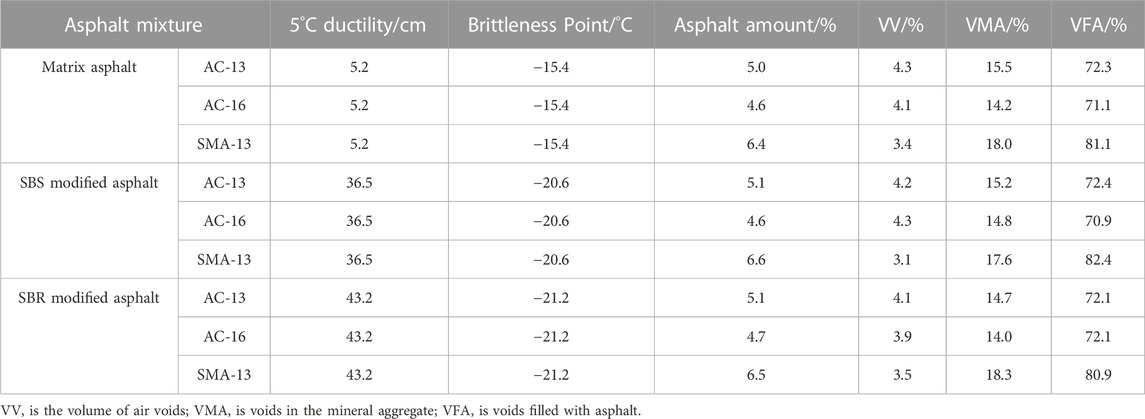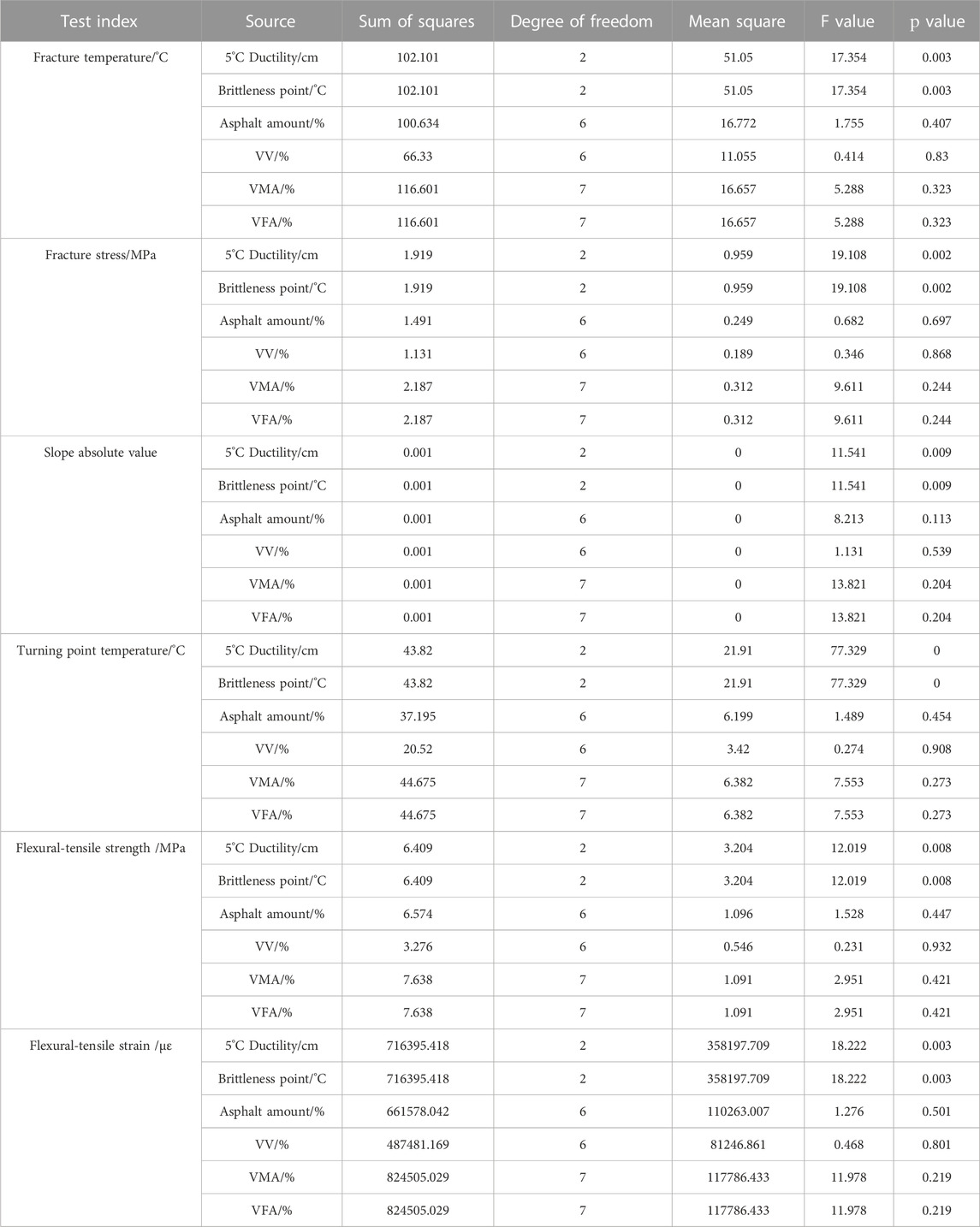- 1FHCC State Key Laboratory of Road Engineering Safety and Health in Cold and High-Altitude Regions, Xi’an, China
- 2School of Civil Engineering, Chongqing Jiaotong University, Chongqing, China
The temperature in the southwest Castel highland area is relatively low, and the asphalt concrete on the road surface is in a low-temperature state all year round. Strong ultraviolet radiation will interfere with the material and cause it to fracture and damage. This paper uses a low-temperature bending test and thermal stress constrained specimen test (TSRST) to test the low-temperature performance of asphalt mixtures with different gradation and asphalt types under different ultraviolet (UV) aging conditions. Existing studies are mainly based on asphalt aging, which cannot take into account the interactions between the binder and aggregate phases during aging. This paper analyzes the correlation between test indexes after UV aging and asphalt mixture parameters, as well as the impact of UV on asphalt mixtures, and the mechanical strength prediction model was established. The results indicate that when the aging time is less than 2 months, the low-temperature performance degradation rate of the asphalt mixture first accelerates and then gradually slows down. The degree of influence of ultraviolet radiation on different graded asphalt mixtures is in descending order: stone asphalt concrete, AC 16 asphalt concrete, and AC-13 asphalt concrete. The relationship between fracture thermal stress and asphalt mixture parameters is strong. It is suggested that the appropriate equivalent outdoor aging time is 2 months in the low-temperature performance test of asphalt mixture after UV aging. At the point when there is no UV test condition, the worth acquired by the test is prescribed to consider the UV aging attenuation coefficient, and the matrix asphalt can allude to 0.84; modified asphalt has a value of 0.9. This article is of great significance for guiding the research on thermal stress fracture of low-temperature asphalt concrete in Castel high-altitude areas.
1 Introduction
Flexible pavement is the most important type of roadway structure. It typically consists of an asphalt mixture, semi-rigid material, and granular material. The asphalt mixture is most commonly found on the surface of flexible pavement, directly under the environment’s influence. Thermal stress and shrinkage are observed in the asphalt mixture when the temperature in the highland region of southwestern Castel is low or drops precipitously. This is the point at which the thermal stress surpassing the strength of the material causes the asphalt mixture to break down. Thermal cracks are the name given to these cracks. The asphalt mixture’s thermal crack resistance is assessed using low-temperature performance. The composition of the material, the aggregate, and the asphalt all have an impact, but ultraviolet (UV) radiation is also a major factor (Zeng et al., 2015; de et al., 2013; Li et al., 2017). UV irradiation results in asphalt aging, which affects the mixture’s performance at low temperatures as well as its engineering performance. UV irradiation is particularly strong because of the long duration of the action and the greater degree of influence in the highland region (Xiao et al., 2015) of southwestern Castel (Xiao et al., 2015).
The effects of ultraviolet (UV) aging on asphalt’s physical and chemical properties have been the focus of intense research in recent decades (Yu et al., 2020; Zadshir et al., 2020), with the aging of UV having a greater negative impact on the properties of asphalt compared to thermal aging (Zou et al., 2021). Asphalt’s low-temperature properties suffer the most from UV aging, which is detrimental to its performance at both high and low temperatures (Fang and Tu, 2019; Li et al., 2020). At the same time, many different investigations have demonstrated that irradiation with UV has an impact on the rheological properties of asphalt samples (Cong et al., 2012; Wu et al., 2012; Hu et al., 2018a; Sun et al., 2020). UV irradiation has been shown to have a significant impact on the asphalt mixture’s surface due to the thinness of the asphalt film (Tia et al., 1988). As a result, the asphalt mixture’s UV aging test can mimic the true condition of asphalt pavements.
As opposed to the study of asphalt binders, there is a paucity of studies on the performance of asphalt mixture after aging in the presence of UV radiation. Ahmed et al. (Abouelsaad and White, 2022) studied the effects of thermal aging, UV aging, and conventional thermal oven aging on the elastic modulus of asphalt mixture samples. These observations demonstrated that samples subjected to both heat and UV irradiation aged at a faster rate as a function of time. Ma et al. (Ma, 2014) studied the water stability of the asphalt mixture before and after aging by means of the water immersion rutting test, the freeze-thaw fractionation test, and the Marshall water immersion test using two methods of UV aging: simulation in the indoor environment and exposure to the atmosphere, which showed that water consistency decreased with increasing UV aging time. On asphalt sand, Xie et al. (Xie et al., 2020) conducted an indoor accelerated UV aging test. After UV aging, it was found that the asphalt mixture’s low-temperature performance decreased. After testing the semi-circular flexural strength and fatigue strength of asphalt concrete as a result of UV aging, for example, Wu et al. (Wu et al., 2019) found that the strength and fatigue life of asphalt mixture was decreased by UV radiation.
Due to the high altitude and cold climate in China, the Qinghai-Tibet Plateau has low temperatures, a large temperature differential, and a large amount of UV radiation (Peng et al., 2015). The impact of UV radiation on low-temperature performance should be further considered when designing this region’s asphalt mixture. Although a great deal of research has been conducted on asphalt’s UV aging, there has been little work on the performance of asphalt blends after UV aging. Because the effects of UV aging time, type of asphalt, and type of grading on the low-temperature performance of an asphalt mixture after UV aging are unclear, material selection and design of an asphalt mix in a cold, high-elevation region cannot be guided by this data. The article’s research site was therefore selected as Lhasa City, Tibet. Firstly, the indoor UV-accelerated aging test conditions were determined based on Lhasa’s UV irradiances. Second, the low-temperature performance of asphalt mixtures with various gradation types and asphalt types under various UV aging conditions was evaluated using the low-temperature bending test and the thermal stress restrained specimen test (TSRST). After analyzing the effects of UV aging time, asphalt type, and grading type on the asphalt mixture’s performance at low temperatures, the authors proposed a suitable ultraviolet aging time, applicable asphalt type, and gradation type for both the high-altitude and cold regions. Following analysis of the correlation between test indices and asphalt mixture, the parameters of the mechanical strength prediction model, a low-temperature performance evaluation index of the asphalt blend after UV aging was proposed. The objective of this paper is to guide research on the thermal stress fracture of asphalt concrete at low temperatures in Castel high-altitude areas, and with the use of the design of optimized asphalt concrete material composition at lower temperatures, it might be expected that the service life of asphalt pavements would be better extended; it is possible to improve pavement performance and reduce the cost of road maintenance.
2 Materials and methods
2.1 Materials
2.1.1 Asphalt
The 80/100 pen grade matrix asphalt delivered by Karamay Petrochemical Branch of PetroChina Co., Ltd., Styrene-Butadiene-Styrene Block Copolymer (SBS) modified asphalt, and polymerized Styrene-Butadiene-Rubber (SBR) modified asphalt created by SK HOLDINGS were utilized. In this study, the three asphalts are designated as matrix, SBS, and SBR, and their primary technical indicators are displayed in Table 1.
2.1.2 Aggregate and filler
Diorite was used to make the aggregate, and limestone powder was used to make the filler. Tables 2, 3, 4 represent the technical indicators.
2.1.3 Asphalt mixture
The gradation of AC-13 asphalt concrete (AC-13), AC-16 asphalt concrete (AC-16), and stone mastic asphalt concrete (SMA-13) are shown in Figure 1.
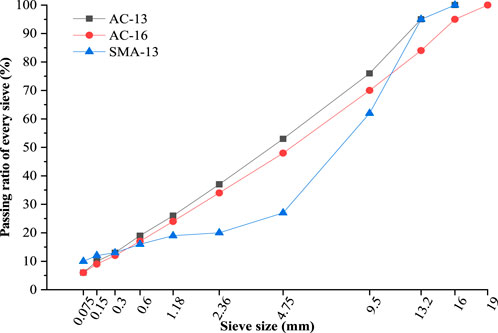
FIGURE 1. Gradation of AC-13 asphalt concrete (AC-13), AC-16 asphalt concrete (AC-16), and stone mastic asphalt concrete (SMA-13).
AC-13, AC-16, and SMA-13 were made with matrix asphalt, SBS-modified asphalt, and SBR-modified asphalt, respectively, to test the asphalt mixture’s low-temperature performance under UV aging. The Marshall test was used to determine the optimal amount of asphalt for the asphalt mixture, as shown in Table 5.
2.2 Test methods
2.2.1 Parameter design of UV aging test
The aging chamber was used for the UV aging test, as shown in Figure 2. A high-pressure Mercury lamp with a power of 1,000 W per square meter was chosen for the UV aging test (Physiogrip, 2008; Wu et al., 2010; Zhang et al., 2016; Li et al., 2019a; Li et al., 2019b). A mirror-glass plate made of stainless steel was installed on top of the test chamber to increase the light intensity. Two blowers were introduced at the front and back of the test chamber to cool the temperature and guarantee the wind stream. The sample’s surface temperature was 45°C–50°C when the temperature gun was used in the test. A solar radiation tester was used to measure the test chamber’s irradiance. The total UV radiation per hour was 0.621 MJ/m2, and the measured UV irradiance was 172.5 W/m2.
Eq. 1 was used to determine the conversion time of the indoor test to the monthly average outdoor UV radiation.
where,
Lhasa was used as a reference for the outdoor irradiance of the cold, high-altitude area chosen for this study. The annual UV radiation was 317.55 MJ/m2, while the average daily UV radiation was 0.87 MJ/m2 (Zhang et al., 2012; Yan et al., 2021; Yan, 2023). There were a total of 0, 2, 4, 6, 8, 10, and 12 months of outdoor aging. The laboratory test time was 0, 86, 171, 256, 342, 427, and 512 h, according to Eq. 1.
2.2.2 Low-temperature bending test
A universal testing machine was used for the low-temperature bending test in accordance with JTG E20-2011 standard T0715-2011 (Code of China, 2011), as shown in Figure 3. The loading rate during the test was 50 mm/min at a temperature of −10°C±0.5°C. The test used nine asphalt mixtures. AC-13, AC-16, and SMA-13 were the gradation types, and the asphalt types were matrix asphalt, SBS-modified asphalt, and SBR-modified asphalt. Five specimens were manufactured for each asphalt mixture at each test condition. The asphalt mixture was rolled into plate-shaped specimens according to T0703-2011 in the JTG E20-2011 standard (Code of China, 2011). The asphalt mixture was initially mixed using the JTG E20-2011 T0702-2011 standard. The second method was to load the mixed asphalt mixture into the test mold and use the small compaction hammer to tamp it once from the edge to the middle and level it in a convex circle. The test mold with the specimen was then placed on top of the wheel mill platform, and the wheel mill was then used to roll the specimen. It had a rolling load of 300N/cm and round-trip rolling of 24 times, such that the specimen was compacted and formed with dimensions of length 300 mm, width 300 mm, and height 50 mm. The specimen was demoulded and sectioned into prisms after 12 h cooling to room temperature. The dimensions of the specimen were 250 mm long, 30 mm wide, and 35 mm tall, as displayed in Figure 4. The specimen underwent UV aging before the low-temperature bending test. The UV aging was exposed to UV radiation on one side and simulated outdoor conditions. The UV radiation side was put through flexural-tensile stress in the test.
The flexural-tensile strength and flexural-tensile strain are used as test indexes, and the parallel test values were normalized. UV aging decay rate was used as the evaluation index, which could be calculated by Eq. 2. The positive value indicates that the performance of the asphalt mixture decreases after aging, while the negative value indicates that the performance of the asphalt mixture improves after aging.
where,
2.2.3 Thermal stress restrained specimen test
The low-temperature bending test under UV aging was used to evaluate the asphalt mixture’s low-temperature performance in a cold and high-altitude region. This is in line with the low-temperature performance evaluation index of the JTG D50-2017 standard (Cod e of China, 2017). However, the field pavement temperature and stress cannot be directly related to flexural-tensile strength and flexural-tensile strain, which are indirect evaluation indices. The TSRST uses fracture temperature and fracture stress as indexes, making it easier to evaluate low-temperature performance (Pszczola et al., 2018; Radevic et al., 2020; Wang et al., 2021).
The TSRST was carried out with the aid of a low-temperature stress constraint instrument, as depicted in Figure 5A, in accordance with the EN 12697-46 standard (Iteh Standards, 2020). By cooling the asphalt mixture specimen and limiting its shrinkage, the test simulated the actual pavement condition. The test started at a temperature of 10°C and was cooling at a rate of 5°C per hour. Nine asphalt mixtures were used in the same manner as in the low-temperature flexural test. Five specimens were fabricated for each asphalt mixture. Figure 5B depicts the specimen’s dimensions of 200 mm in length, 40 mm in width, and 40 mm in height. The specimen was subjected to UV aging prior to the test. The specimen mold was then put in place, as depicted in Figure 5C. Devcon plastic steel repair agent was used in the test to firmly bond the specimen’s upper and lower planes to the chassis. The bonding work was completed in 15 min after glue A and glue B were mixed in a 9:1 ratio. After that, it was left in place for more than 24 h to make sure the specimen and the chassis were well-bonded.
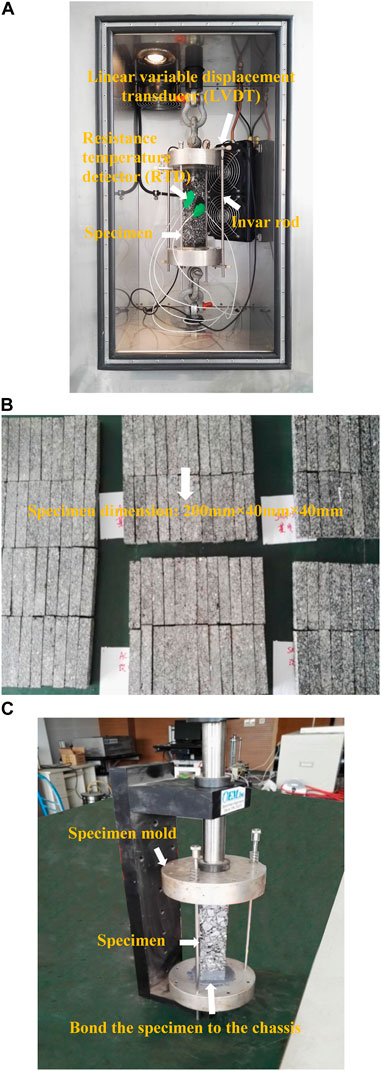
FIGURE 5. Thermal stress restrained specimen test (TSRST): (A) instrument; (B) specimen; (C) specimen model installation.
3 Results and discussion
3.1 Low-temperature bending test
Through the low-temperature bending test, the flexural-tensile strength and flexural-tensile strain attenuation law of asphalt mixtures with various asphalt types and gradation types under various UV aging times were noticed. The asphalt mixture’s capacity to withstand tensile stress at low temperatures is represented by its flexural-tensile strength. The asphalt mixture’s capacity to withstand tensile stress at low temperatures increases with its flexural-tensile strength. The asphalt mixture’s ability to deform at low temperatures is represented by the flexural-tensile strain. The asphalt mixture’s ability to deform at low temperatures is stronger, the greater flexural-tensile strain (Lv, 2012; Zhu et al., 2017; Cheng et al., 2018; Wei et al., 2019; Li et al., 2022; Yang et al., 2022; Yang and Liu, 2022; Gao et al., 2023).
3.1.1 The effect of UV aging time on low-temperature bending test results
Figures 6, 7 show the low-temperature bending test results of the asphalt mixture under different aging times. With the augmentation of UV aging time, the flexural-tensile strength and flexural-tensile strain of each asphalt mixture overall showed a reducing trend. It showed clear attenuation and afterward changed gradually after the indoor aging time was 86 h, which is comparable to 2 months spent outside.
This could be on the grounds that UV light has a short wave and a shallow radiation profundity (Feng et al., 2013; Hu et al., 2018b; Zeng et al., 2018). When the outdoor aging was 2 months, the surface of the asphalt mixture had fully aged, while the asphalt mixture below the surface had a slower aging speed and less impact. Ahmed et al. (Abouelsaad and White, 2022) led tests on the asphalt mixture’s resilient modulus under an assortment of UV aging conditions and found that the resilient modulus essentially increased following 56 days of open-air aging. This is practically identical to the review’s decision. Thus, it is recommended that the fitting identical outside aging age be 2 months for the low-temperature performance test of the asphalt mixture subsequent to aging.
3.1.2 The effect of gradation type on low-temperature bending test results
Figure 8 shows the test results of asphalt mixtures of different gradation types under UV aging. When the equivalent outdoor aging time was 2 months, the average flexural-tensile strength decay rate of SMA-13 was 1.23 times that of AC-13 and 1.09 times that of AC-16. The average flexural-tensile strain decay rate of SMA-13 was 1.22 times that of AC-13 and 1.18 times that of AC-16. It showed that under the same UV aging conditions, the degree of low-temperature performance degradation from large to small was as follows: SMA-13, AC-16, and AC-13.
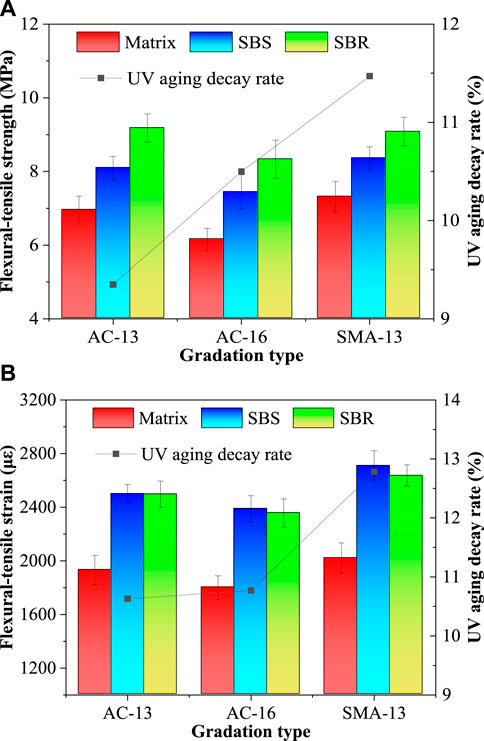
FIGURE 8. Low-temperature bending test results of asphalt mixtures of different gradation types under UV aging: (A) Flexural-tensile strength and decay rate of asphalt mixtures; (B) Flexural-tensile strain and decay rate of asphalt mixtures.
This could be related to the amount of asphalt in the mixture as well as the void. The asphalt film thickens as the asphalt content rises. The asphalt mixture’s aging becomes more significant as the asphalt binder affected by UV aging increases on its surface (Yamaguchi et al., 2005). With the increment of the void, the impact profundity of UV aging becomes further, and the aging of asphalt mixtures turns out to be more serious.
3.1.3 The effect of asphalt type on low-temperature bending test results
Figure 9 depicts the results of the low-temperature bending tests for various asphalt types aged by UV light. The average decay rate of the matrix asphalt mixture’s flexural-tensile strength was 2.14 times that of the SBS-modified asphalt mixture and 1.46 times that of the SBR-modified asphalt mixture when the equivalent outdoor aging time was 2 months. The typical flexural-tensile strain decay rate of matrix asphalt was 2.17 seasons for the SBS-modified asphalt mixture and 1.48 seasons for the SBR-modified asphalt mixture.
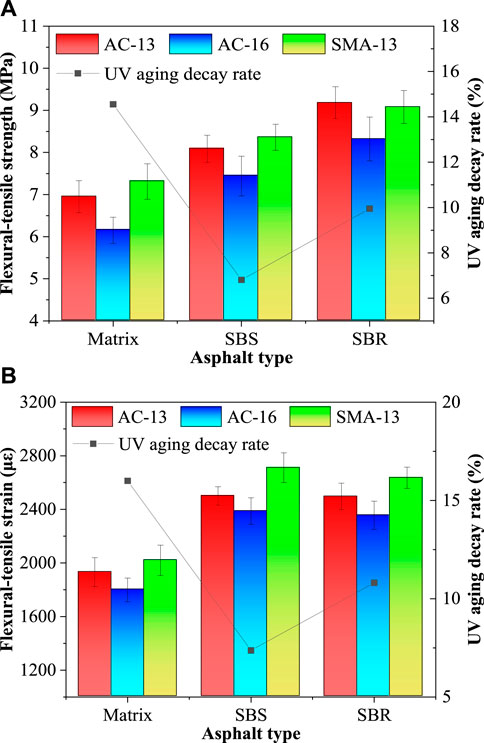
FIGURE 9. Low-temperature bending test results of asphalt mixtures of different asphalt types under UV aging: (A) Flexural-tensile strength and decay rate of asphalt mixtures; (B) Flexural-tensile strain and decay rate of asphalt mixtures.
It demonstrated that, under the same UV aging conditions, the following levels of large to small performance degradation at low temperatures occurred: SBS-modified asphalt, SBR-modified asphalt, and matrix asphalt mixture.
The decay law of the asphalt mixture’s low-temperature performance was compared using various asphalt types and gradation types. After UV aging, it was discovered that the type of asphalt had a greater impact on the asphalt mixture’s low-temperature performance than the type of gradation.
The low-temperature bending test under UV aging can be used to assess the asphalt mixture’s low-temperature performance in cold and high-altitude regions. The UV aging attenuation coefficient, which is the ratio of the value obtained by the test under UV aging to the value obtained by the conventional test, should be taken into consideration when the test value is determined under the absence of UV aging. Matrix asphalt’s reference value is 0.84, while modified asphalt’s is 0.9.
3.2 Thermal stress restrained specimen test
The test indexes decay law of asphalt mixtures containing various asphalt types and gradations under UV aging was observed using the TSRST. The turning point temperature, fracture temperature, fracture stress, and absolute slope value are the TSRST test indexes. The temperature at which the specimen breaks is known as the fracture temperature. This temperature can directly reflect the lowest temperature that the asphalt mixture can withstand. The specimen’s fracture toughness reflects the maximum strength of the asphalt blend during the temperature shrinkage process. The specimen’s temperature-stress curve transitions from a curve to a straight line at the turning point temperature, indicating the asphalt mixture’s low-temperature stress relaxation capacity. The specimen’s straight temperature-stress curve slope, which reflects the rate of thermal stress growth, is the slope absolute value (Pszczola et al., 2019).
3.2.1 The effect of gradation type on TSRST results
The TSRST results of asphalt mixtures with various gradations undergoing UV aging are depicted in Figure 10. When assessing the degree of degradation in the low-temperature performance of the asphalt mixture, fracture temperature and fracture stress exhibited good consistency, and the evaluation results were in line with the findings of the low-temperature bending test. The following was the degradation degree of fracture temperature and fracture stress from large to small under the same UV aging conditions: AC-13, SMA-13, and AC-16.

FIGURE 10. TSRST results of asphalt mixtures of different gradation types under UV aging: (A) Fracture temperature and decay rate of asphalt mixtures; (B) Fracture stress and decay rate of asphalt mixtures; (C) Slope absolute value and decay rate of asphalt mixtures; (D) Turning point temperature and decay rate of asphalt mixtures.
3.2.2 The effect of asphalt type on TSRST results
The TSRST results of asphalt mixtures of various asphalt types aged under UV light are depicted in Figure 11. At the time of assessing the degree of degradation in the low-temperature performance of the asphalt mixture, the fracture temperature, the fracture stress, and the slope absolute value were all consistent The degradation degree of fracture temperature, fracture stress, and slope absolute values from large to small under the same UV aging conditions were as follows: SBS-modified asphalt, SBR-modified asphalt, and matrix asphalt mixture.
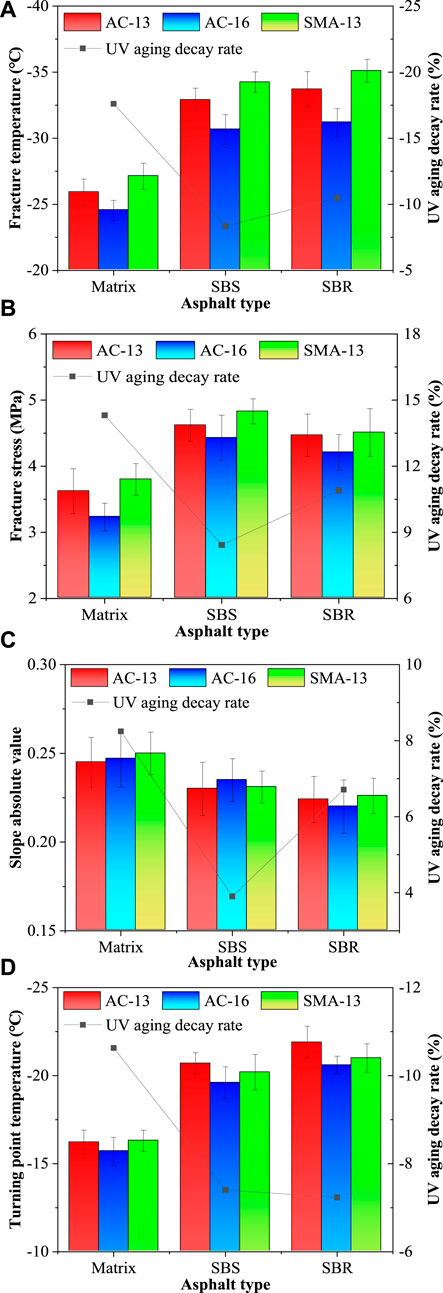
FIGURE 11. TSRST results of asphalt mixtures of different asphalt types under UV aging: (A) Fracture temperature and decay rate of asphalt mixtures; (B) Fracture stress and decay rate of asphalt mixtures; (C) Slope absolute value and decay rate of asphalt mixtures; (D) Turning point temperature and decay rate of asphalt mixtures.
3.3 The effect of asphalt and asphalt mixture parameters on test indexes
The aforementioned research demonstrates that the asphalt type and gradation type have an impact on the low-temperature performance test results of asphalt mixtures. To examine the influence of endless asphalt blend boundaries, SPSS Statistics 25 was utilized as an information examination tool. The correlation between the asphalt and asphalt mixture’s key parameters and test indexes was examined using correlation analysis. The brittleness points and 5°C ductility were chosen as key boundaries of asphalt. The key parameters of the asphalt mixture were the asphalt amount, the volume of air voids (VV), voids in mineral aggregate (VMA), and voids filled with asphalt (VFA). Table 6 displays each asphalt mixture’s most important parameters.
The ANOVA analysis was performed by taking the test indexes as dependent variables and taking the key parameters of asphalt and asphalt mixture as independent variables. The analysis results are summarized in Table 7.
It can be seen from Table 7 that the p values of ductile points and brittle points are less than 0.05, while the p values of other parameters are greater than 0.05. It indicates that the asphalt ductility and brittleness point have a significant influence on the test indexes, while other parameters have no significant influence on the test indexes.
A data analysis technique called correlation analysis is used to measure the degree of correlation between variables. The correlation coefficient is represented by r. When

TABLE 8. The correlation coefficient between test indexes and key parameters of asphalt and asphalt mixture.
According to Table 8, the asphalt parameters like brittleness point and ductility at 5°C had a good correlation with the test indexes. The parameters of asphalt mixture, for example, asphalt amount, VV, VMA, and VFA, had a low or frail relationship with the test indexes. This suggests that asphalt mixture parameters have less of an impact on asphalt mixture’s low-temperature performance than do asphalt parameters (Hannele et al., 1996; Kaseer et al., 2021). As a result, test indexes change with the asphalt type with good regularity. The asphalt mixture parameters, on the other hand, have a weak correlation with the turning point temperature and slope absolute value. As a result, the gradation type has little effect on the absolute slope value or turning point temperature.
It demonstrates that fracture temperature and fracture stress can more accurately characterize the asphalt mixture’s low-temperature performance than slope absolute value or turning point temperature. In this way, the fracture temperature and fracture stress are likely to assess the low-temperature performance of the asphalt mixture after UV aging by utilizing TSRST. This is reliable with the current research conclusions on the low-temperature performance of asphalt mixture (Velasquez et al., 2009; Farrar et al., 2013; Pszczoła and Judycki, 2015).
Regression analysis was used to establish a mathematical model for predicting fracture temperature, fracture stress, flexural-tensile strength, and flexural-tensile strain with key parameters. In order to analyze the applicable regression analysis methods, a standard multiple linear regression model was first constructed, and collinearity statistics of independent variables were carried out. The analysis results are shown in Table 9.
It can be seen that the tolerance on the independent variables is below 0.2, and the VIF value is greater than 10, suggesting multicollinearity between independent variables. For collinear data analysis, the ridge regression approach may be used. The prediction model of fracture temperature and fracture stress was established by the Ridge regression method, as shown in Eqs 3, 4, 5, 6.
where,
The correlation and ANOVA analyses of the model are shown in Table 10.
The results of correlation and ANOVA analyses show that the correlation coefficient of the Ridge regression model is more than 0.86, and the p-value is less than 0.05. It indicates that the established prediction model has a high correlation coefficient and statistical significance.
To obtain the test index prediction model established in the current study, regression was performed on the test data, which has a reference value for predicting the low-temperature performance of different asphalt mixtures. But the independent variable is only the bitumen parameter and there are few variables. Many experiments are needed to further test the reliability of this model.
4 Conclusion
In this study, the UV-accelerated aging test conditions were determined based on the UV irradiance in Lhasa. The low-temperature performance of asphalt mixtures with different gradation and asphalt types under different UV aging conditions were tested by low-temperature bending test and TSRST. The correlation between the index of test indexes and asphalt mixture parameters was analyzed, and the mechanical strength prediction model was established. The results of this study can guide research into the thermal stress fracture of asphalt concrete at low temperatures in high-elevation areas of Castel. By optimizing the composition of low-temperature asphalt concrete materials, the service life of asphalt pavements can be better extended, pavement performance can be improved, and road maintenance costs can be reduced. The main conclusions are as follows:
(1) When the indoor aging time was 86h, which means 2 months outdoor, the low-temperature performance of the asphalt mixture showed obvious attenuation and then changed slowly. In the low-temperature performance test of asphalt mixture after UV aging, the appropriate equivalent outdoor aging time is 2 months.
(2) The degree of UV influence on asphalt mixtures with various gradations from large to small is as follows: SMA-13, AC-16, and AC-13. The degree of UV influence on asphalt mixtures containing various types of asphalt is as follows: matrix asphalt, SBR-modified asphalt, and SBS-modified asphalt.
(3) Contrasted and gradation type: the asphalt type impacts the low-temperature performance of the asphalt mixture after UV aging. At the point when there is no UV test condition, the worth acquired by the test is prescribed to consider the UV aging attenuation coefficient, and the matrix asphalt can allude to 0.84; modified asphalt has a value of 0.9.
Data availability statement
The original contributions presented in the study are included in the article/supplementary material, further inquiries can be directed to the corresponding author.
Author contributions
Conceptualization, WK; methodology, WK; software, WK; validation, TC; formal analysis, WK; investigation, YL; resources, HC; data curation, YL; writing—original draft preparation, WK; writing—review and editing, WK; visualization, HC; supervision, TC; project administration, YL; funding acquisition, WK. All authors contributed to the article and approved the submitted version.
Funding
This research was funded by the National Key R&D Program of China (grant number: 2021YFB2601200) and the Science and Technology project of the Transportation Department of Tibet Autonomous Region (grant number: XZJTKJ[2020]03).
Conflict of interest
The authors declare that the research was conducted in the absence of any commercial or financial relationships that could be construed as a potential conflict of interest.
Publisher’s note
All claims expressed in this article are solely those of the authors and do not necessarily represent those of their affiliated organizations, or those of the publisher, the editors and the reviewers. Any product that may be evaluated in this article, or claim that may be made by its manufacturer, is not guaranteed or endorsed by the publisher.
References
Abouelsaad, A., and White, G. (2022). The combined effect of ultraviolet irradiation and temperature on hot mix asphalt mixture aging. Sustainability 14, 5942. doi:10.3390/su14105942
Akaike, H . (1976). Canonical correlation analysis of time series and the use of an information criterion. Math. Sci. Eng. 126, 27–96. doi:10.1016/S0076-5392(08)60869-3
Anderson, T. (1999). Asymptotic theory for canonical correlation analysis. J. Multivar. Anal. 70, 1–29. doi:10.1006/jmva.1999.1810
Cheng, Y., Yu, D., Tan, G., and Zhu, C. (2018). Low-temperature performance and damage constitutive model of eco-friendly basalt fiber-diatomite-modified asphalt mixture under freeze-thaw cycles. Materials 11, 2148. doi:10.3390/ma11112148
Code of China (2011). Standard test methods of bitumen and bituminous mixtures for highway engineering; JTG E20-2011. Available online: https://www.nssi.org.cn/nssi/front/77462783.html (accessed on September 13, 2011).
Cong, P., Wang, J., Li, K., and Chen, S. (2012). Physical and rheological properties of asphalt binders containing various antiaging agents. Fuel 97, 678–684. doi:10.1016/j.fuel.2012.02.028
de, S., Lins, V. D., Pasa, V. M., and Leite, L. F. (2013). Weathering aging of modified asphalt binders. Fuel Process. Technol. 115, 19–25. doi:10.1016/j.fuproc.2013.03.029
Fang, J. M., and Tu, J. S. (2019). Effect of ultraviolet (UV) aging on rheology properties and microstructure of polyurethane (PU) modified asphalt. Mater. Res. Express 6, 125318. doi:10.1088/2053-1591/ab558f
Farrar, M., Hajj, E., Planche, J., and Alavi, M. (2013). A method to estimate the thermal stress build-up in an asphalt mixture from a single-cooling event. Road. Mater. Pavement. 14, 201–211. doi:10.1080/14680629.2013.774756
Feng, Z., Yu, J., Zhang, H., Kuang, D., and Xue, L. (2013). Effect of ultraviolet aging on rheology, chemistry and morphology of ultraviolet absorber modified bitumen. Mater. Struct. 46, 1123–1132. doi:10.1617/s11527-012-9958-3
Gao, Y., Yu, Z., Chen, W., Yin, Q., Wu, J., and Wang, W. (2023). Recognition of rock materials after high-temperature deterioration based on SEM images via deep learning. J. Mater. Res. Technol. 25, 273–284. doi:10.1016/j.jmrt.2023.05.271
Hannele, K., Zubeck, T., and Vinson, S. (1996). Prediction of low-temperature cracking of asphalt concrete mixtures with thermal stress restrained specimen test results. Transp. Res. Rec. 1545, 50–58. doi:10.1177/0361198196154500107
Hu, J., Wu, S., Liu, Q., García, H., Zeng, W., Nie, S., et al. (2018b). The effect of ultraviolet radiation on bitumen aging depth. Materials 11, 747. doi:10.3390/ma11050747
Hu, J., Wu, S., Liu, Q., Hernández, M. I. G., and Zeng, W. (2018a). Effect of ultraviolet radiation on bitumen by different ageing procedures. Constr. Build. Mater. 163, 73–79. doi:10.1016/j.conbuildmat.2017.12.014
Iteh Standards (2020). Bituminous mixtures-Test methods for hot mix asphalt-Part 46: Low temperature cracking and properties by uniaxial tension tests; EN 12697-46.
Kaseer, F., Martin, A. E., and Arámbula-Mercado, E. (2021). Relationship between rheological indices and cracking performance of virgin, recycled and rejuvenated asphalt binders and mixtures. Transp. Res. Rec. 2675, 93–109. doi:10.1177/03611981211007479
Li, H. L., Tong, P. P., Zhang, X. J., Lin, X. X., and Li, B. (2020). Influence of ultraviolet and oxygen coupling aging on rheological properties and functional group index of warm mix asphalt binder. Materials 13, 4216. doi:10.3390/ma13194216
Li, R., Xiao, F., Amirkhanian, S., You, Z., and Huang, J. (2017). Developments of nano materials and technologies on asphalt materials-A review. Constr. Build. Mater. 143, 633–648. doi:10.1016/j.conbuildmat.2017.03.158
Li, S., Xu, W., Zhang, F., Wu, H., and Zhao, P. (2022). Effect of graphene oxide on the low-temperature crack resistance of polyurethane-SBS-modified asphalt and asphalt mixtures. Polymers 14, 453. doi:10.3390/polym14030453
Li, Y., Wu, S., Liu, Q., Dai, Y., Li, C., Li, H., et al. (2019b). Aging degradation of asphalt binder by narrow-band UV radiations with a range of dominant wavelengths. Constr. Build. Mater. 220, 637–650. doi:10.1016/j.conbuildmat.2019.06.035
Li, Y., Wu, S., Liu, Q., Xie, J., Li, H., Dai, Y., et al. (2019a). Aging effects of ultraviolet lights with same dominant wavelength and different wavelength ranges on a hydrocarbon-based polymer (asphalt). Polym. Test. 75, 64–75. doi:10.1016/j.polymertesting.2019.01.025
Lv, S. (2012). Study on low temperature performance evaluation index of asphalt mixture based on bending test at low temperature. Appl. Mech. Mater. 193-194, 427–430. doi:10.4028/www.scientific.net/amm.193-194.427
Ma, L. (2014). Research on water stability of ultraviolet aging asphalt mixture. Highw. Eng. 39, 160–169. doi:10.3969/j.issn.1674-0610.2014.05.036
Peng, S., Du, Q., Wang, L., Lin, A., and Hu, B. (2015). Long-term variations of ultraviolet radiation in Tibetan plateau from observation and estimation: Ultraviolet radiation in Tibetan plateau. Int. J. Climatol. 35, 1245–1253. doi:10.1002/joc.4051
Physiogrip (2008). Method of measurement of ultraviolet irradiance and electrical characteristic of tubular ultraviolet high-pressure mercu-ry lamp; QB/T 2989-2008. Available online: http://hbba.sacinfo.org.cn/stdDetail/79a4abb75df8e90f38c6d46421aa63cd (accessed on June 16, 2008).
Pszczola, M., Jaczewski, M., Rys, D., Jaskula, P., and Szydlowski, C. (2018). Evaluation of asphalt mixture low-temperature performance in bending beam creep test. Materials 11, 100. doi:10.3390/ma11010100
Pszczoła, M., and Judycki, J. (2015). Comparison of calculated and measured thermal stresses in asphalt concrete. Balt. J. Road. Bridge E. 10, 39–45. doi:10.3846/bjrbe.2015.05
Pszczola, M., Szydlowski, C., and Jaczewski, M. (2019). Influence of cooling rate and additives on low-temperature properties of asphalt mixtures in the TSRST. Constr. Build. Mater. 204, 399–409. doi:10.1016/j.conbuildmat.2019.01.148
Radevic, A., Isailovic, I., Wistuba, M., Zakic, D., Oreskovic, M., and Mladenovic, G. (2020). The impact of recycled concrete aggregate on the stiffness, fatigue, and low-temperature performance of asphalt mixtures for road construction. Sustain. (Basel, Switz. 12, 3949. doi:10.3390/su12103949
Sun, X., Qin, X., Liu, Z., Yin, Y., Zou, C., and Jiang, S. (2020). New preparation method of bitumen samples for UV aging behavior investigation. Constr. Build. Mater. 233, 117278. doi:10.1016/j.conbuildmat.2019.117278
Tia, M., Ruth, B., and Charal, C. (1988). Investigation of original and in-service asphalt properties for the development of improved specifications-final phase of testing and analysis. Gainesville, FL, USA: University of Florida.
Velasquez, R., Labuz, J., Marasteanu, M., and Zofka, A. (2009). Revising thermal stresses in the TSRST for low-temperature cracking prediction. J. Mater. Civ. Eng. 21, 680–687. doi:10.1061/(asce)0899-1561(2009)21:11(680)
Wang, J., Ng, P., Gong, Y., Su, H., and Du, J. (2021). Experimental study of low temperature performance of porous asphalt mixture. Appl. Sci. 11, 4029. doi:10.3390/app11094029
Wei, H., Bai, X., Qian, G., Wang, F., Li, Z., Jin, J., et al. (2019). Aging mechanism and properties of SBS modified bitumen under complex environmental conditions. Materials 12, 1189. doi:10.3390/ma12071189
Wu, S., Han, J., Pang, L., Yu, M., and Wang, T. (2012). Rheological properties for aged bitumen containing ultraviolate light resistant materials. Constr. Build. Mater. 33, 133–138. doi:10.1016/j.conbuildmat.2012.01.019
Wu, S., Pang, L., Liu, G., and Zhu, J. (2010). Laboratory study on ultraviolet radiation aging of bitumen. J. Mater. Civ. Eng. 22, 767–772. doi:10.1061/(asce)mt.1943-5533.0000010
Wu, S., Ye, Y., Li, Y., Li, C., Song, W., Li, H., et al. (2019). The effect of UV irradiation on the chemical structure, mechanical and self-healing properties of asphalt mixture. Materials 12, 2424. doi:10.3390/ma12152424
Xiao, F., Amirkhanian, S. N., Karakouzian, M., and Khalili, M. (2015). Rheology evaluations of WMA binders using ultraviolet and PAV aging procedures. Constr. Build. Mater. 79, 56–64. doi:10.1016/j.conbuildmat.2015.01.046
Xie, X., Li, H., Duan, J., Li, G., and Tong, S. (2020). Influence of the mineral powder content on the asphalt aging resistance in high-altitude areas based on indoor ultraviolet light tests. Materials 13, 754. doi:10.3390/ma13030754
Yamaguchi, K., Sasaki, I., Nishizaki, I., Meiarashi, S., and Moriyoshi, A. (2005). Effects of film thickness, wavelength, and carbon black on photodegradation of asphalt. J. Jpn. Pet. Inst. 48, 150–155. doi:10.1627/jpi.48.150
Yan, J. H. (2023). Research on roof dip angle in high altitude area based on solar radiation: A case study of Lhasa city. Intelligent Build. City Inf. 317, 104–106. doi:10.13655/j.cnki.ibci.2023.04.030
Yan, R., Huang, L., Ru, T. S., Dan, Z., Si, L., and Luo, S. (2021). Analysis of variation characteristics of ultraviolet radiation intensity index in Lhasa. Mod. Cml. Rsrch. 87, 41–44. doi:10.3969/j.issn.1672-8114.2021.10.021
Yang, B. B., and Liu, Y. (2022). Application of fractals to evaluate fractures of rock due to mining. Fractal Fract. 6, 96. doi:10.3390/fractalfract6020096
Yang, B. B., Yuan, S., Shen, Z. Z., and Zhao, X. M. (2022). Influence of geotextile materials on the fractal characteristics of desiccation cracking of soil. Fractal Fract. 6, 628. doi:10.3390/fractalfract6110628
Yu, H. N., Shen, S. H., Qian, G. P., and Gong, X. B. (2020). Packing theory and volumetrics-based aggregate gradation design method. J.Mater. Civ. Eng. 32, 04020110. doi:10.1061/(asce)mt.1943-5533.0003192
Zadshir, M., Ploger, D., Yu, X. K., Sangiorgi, C., and Yin, H. M. (2020). Chemical, thermophysical, rheological, and microscopic characterisation of rubber modified asphalt binder exposed to UV radiation. Road. Mater. Pavement Des. 21, S123–S139. doi:10.1080/14680629.2020.1736606
Zeng, W., Wu, S., Pang, L., Chen, H., Hu, J., Sun, Y., et al. (2018). Research on Ultra Violet (UV) aging depth of asphalts. Constr. Build. Mater. 160, 620–627. doi:10.1016/j.conbuildmat.2017.11.047
Zeng, W., Wu, S., Wen, J., and Chen, Z. (2015). The temperature effects in aging index of asphalt during UV aging process. Constr. Build. Mater. 93, 1125–1131. doi:10.1016/j.conbuildmat.2015.05.022
Zhang, C., Yu, J., Xu, S., Xue, L., and Cao, Z. (2016). Influence of UV aging on the rheological properties of bitumen modified with surface organic layered double hydroxides. Constr. Build. Mater. 123, 574–580. doi:10.1016/j.conbuildmat.2016.07.048
Zhang, X., Hu, B., Wang, Y., Zhang, W., He, Y., and Sun, W. (2012). The analysis of variation characteristics and establishing of estimating equation for ultraviolet radiation in Lhasa. Chin. J. Atmos. Sci. 36, 744–754. doi:10.3878/j.issn.1006-9895.2012.11165
Zhu, Y., Dave, E. V., Rahbar-Rastegar, R., Daniel, J., and Zofka, A. (2017). Comprehensive evaluation of low-temperature fracture indices for asphalt mixtures. Road. Mater. Pavement. 18, 467–490. doi:10.1080/14680629.2017.1389085
Keywords: castor high altitude area, asphalt concrete, low temperature performance, fracture stress, attenuation coefficient
Citation: Ke W, Lei Y, Chen T and Cao H (2023) Research on thermal stress fracture performance of low-temperature asphalt concrete in castel high altitude area. Front. Earth Sci. 11:1206195. doi: 10.3389/feart.2023.1206195
Received: 15 April 2023; Accepted: 07 June 2023;
Published: 20 June 2023.
Edited by:
Binbin Yang, Xuchang University, ChinaReviewed by:
Jianwen Shao, Tianjin University, ChinaNicola Baldo, University of Udine, Italy
Xin Li, Shandong University, China
Copyright © 2023 Ke, Lei, Chen and Cao. This is an open-access article distributed under the terms of the Creative Commons Attribution License (CC BY). The use, distribution or reproduction in other forums is permitted, provided the original author(s) and the copyright owner(s) are credited and that the original publication in this journal is cited, in accordance with accepted academic practice. No use, distribution or reproduction is permitted which does not comply with these terms.
*Correspondence: Wenhao Ke, a2V3ZW5oYW8yMjVAb3V0bG9vay5jb20=
 Wenhao Ke
Wenhao Ke Yu Lei1
Yu Lei1